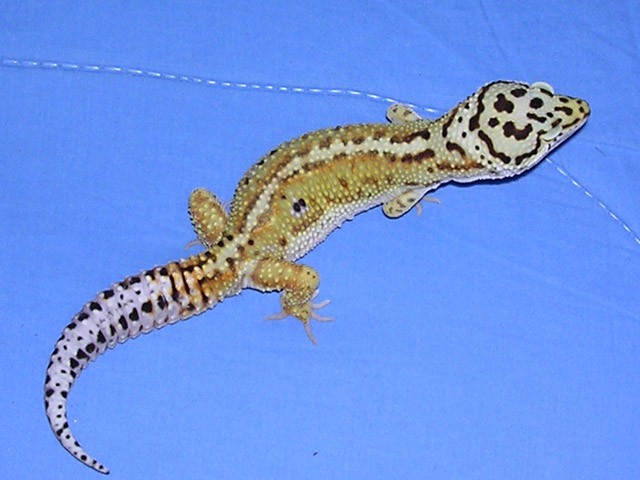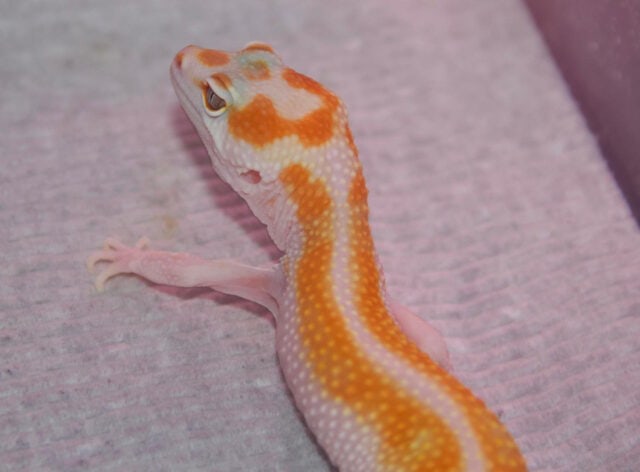The Red Stripe Leopard Gecko is a colorful lizard that many people love to have as a pet. It gets its name from the special red stripes it has along its body. These geckos are orange or yellow, and they have two red stripes that go along their backs. This kind of gecko is different because it was specially bred, or designed, to have these red stripes.
When the little geckos are born, they are actually brown where the red stripes will be. As they grow up, around six months old, the red stripes start to show up. The Red Stripe Leopard Geckos have even been mixed with other types of geckos, making new kinds with different colors and patterns.
Appearance: The Red Stripe Leopard Gecko features a vibrant orange or yellow body highlighted by two red stripes on either side of a dorsal stripe.
Breeding Age: Geckos are typically ready for breeding around the age of one year.
Optimal Conditions: Ensure a temperature range of 75-90°F with humidity levels of 20-40% for their comfort. Eggs should be incubated between 80 and 85°F.
Purchase Tips: When buying, choose geckos that are active with clear eyes, healthy skin, and a full tail for signs of good health.
Essential Accessories: New gecko owners will need a terrarium, heat source, water dish, hiding place, and a steady diet of insects like crickets or mealworms.
What Does The Red Stripe Leopard Gecko Look Like?

The Red Stripe Leopard Gecko is truly a sight to behold, with its dazzling colors and unique patterns. Its body is mainly orange or yellow, but what really stands out are the two red stripes that run along either side of a dorsal stripe on its back. These stripes give the gecko its name and make it look different from other leopard geckos.
Every Red Stripe Leopard Gecko has its own special look because the stripes can be really bold or a bit fainter. It’s this variety that makes each one special and different. Other than its striking color, it has the usual features of leopard geckos, like a robust body, spindly legs, and a fat tail.
How Can You Get a Red Stripe Leopard Gecko?
Getting a Red Stripe Leopard Gecko can be an exciting venture, whether you decide to breed one yourself or buy one. There are specific things to consider and steps to follow to make sure you bring home a healthy and happy gecko. Besides the way it looks (there are many morphs, including Radar Leos)
Red Stripe Leopard Gecko Breeding

Breeding a Red Stripe Leopard Gecko might seem complex, but with the right information, it can be a rewarding experience. First, it’s important to know the right breeding age; usually, geckos are ready to breed when they are about one year old. Picking compatible geckos is also crucial, as it ensures a smoother breeding process.
When it comes to creating the right environment, paying attention to temperature and humidity is key. The enclosure should be kept at a temperature between 75 and 90 degrees Fahrenheit, and humidity levels should be maintained around 20-40%. These conditions help in creating a comfortable nesting place where the female can lay her eggs.
Once the eggs are laid, they need proper incubation conditions. The incubation period is vital and requires a stable temperature to ensure the eggs develop correctly. Typically, gecko eggs are incubated at temperatures between 80 and 85 degrees Fahrenheit. Maintaining these conditions is crucial as it affects the development and health of the baby geckos.
Buying a Red Stripe Leopard Gecko
Purchasing a Red Stripe Leopard Gecko can be quite exciting but it’s important to know what to look for to ensure you choose a healthy one (it can be an issue for some morphs, such as the Lemon Frost, but the Red Stripe is fine). Look for geckos that are active, have clear eyes, healthy skin, and a full tail as these are signs of a healthy gecko. Avoid ones with visible wounds or abnormalities, as these can be signs of underlying health issues.
Once you’ve picked the perfect gecko, preparing a comfy home for it is the next step. First-time gecko owners will need to invest in some essential accessories. A suitable terrarium is a must, along with a heat source to maintain the right temperature.
Geckos also need a water dish, a hiding place, and appropriate substrate or bedding. It’s also crucial to have the correct diet ready; geckos usually eat insects like crickets or mealworms, so having a supply of these is necessary.